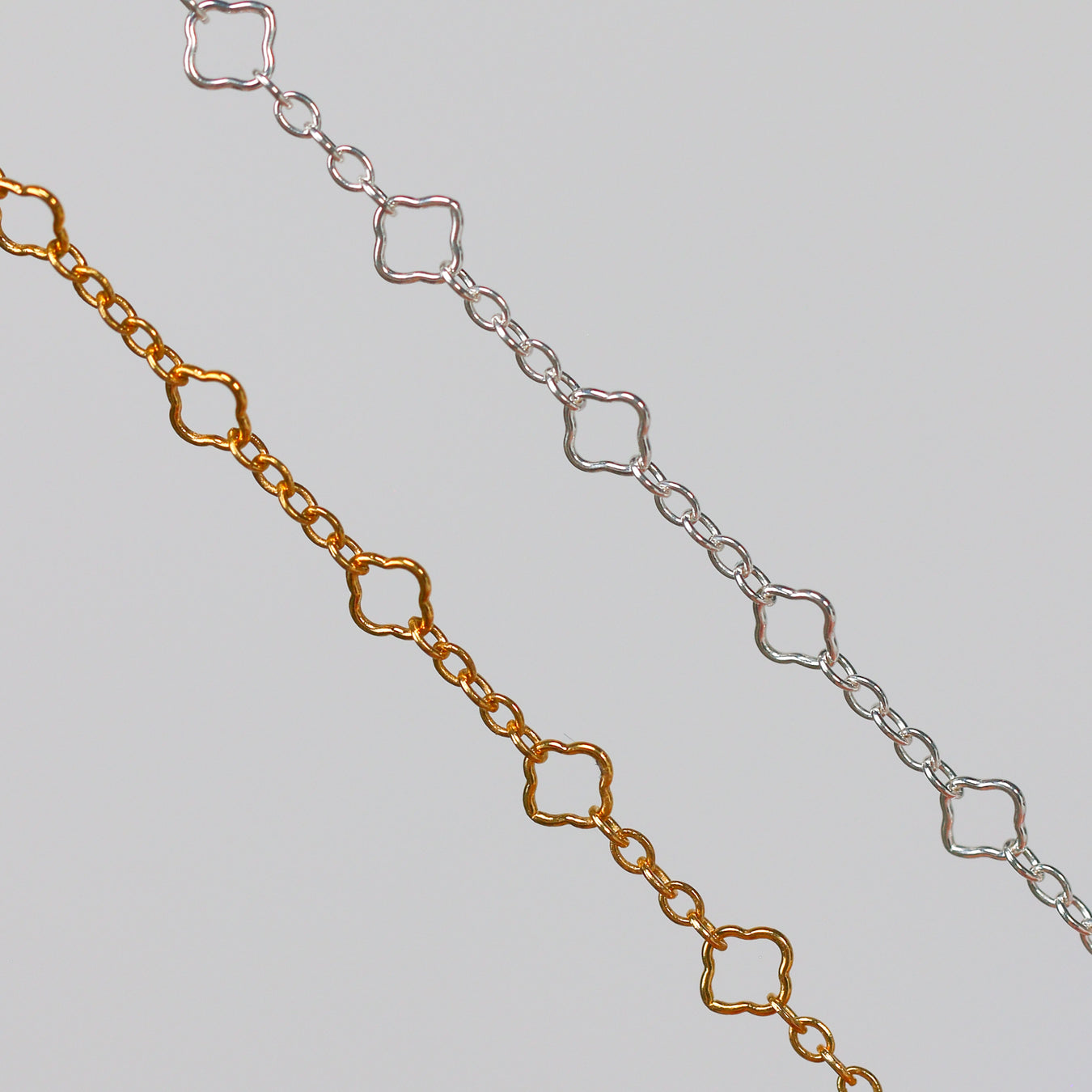Reach out to speak with a Permanent Jewelry Expert by calling +1 801-658-0015 or by filling out the contact form linked here.

Alessia
Clover Chain

One of the most common questions new permanent jewelry artists ask is whether to use dainty chains or strong chains for their pieces. The answer depends on your client, the look you’re going for, and how much wear and tear the jewelry will face. This guide breaks down the strengths and weaknesses of both styles so you can confidently match each customer with the perfect chain.
Every permanent jewelry weld is only as reliable as the chain it connects. A delicate chain may look beautiful, but if it’s too thin for daily wear, it could stretch or break under stress. On the other hand, a heavier chain offers durability and structure but can overpower smaller wrists or minimalist aesthetics.
The goal is to find a balance, choosing a chain that fits your client’s lifestyle, aesthetic preference, and comfort level.
Dainty chains feature smaller links and lighter gauges, usually between 0.5 mm and 1.0 mm thick. These chains have a subtle, elegant appearance that blend seamlessly into the skin, making them ideal for minimalist or fine jewelry lovers.
Pros:
Elegant and minimal look
Great for layering with multiple pieces
Feels light and comfortable to wear
Considerations:
May require gentler weld settings
More prone to stretching or breaking with heavy wear
Best for low-impact daily activities
(Be sure to checkout pictures of the popular dainty chains at the bottom of this article!)
Popular Dainty Chains:
Alessia Clover Chain
https://permanentjewelry.sunstonewelders.com/products/alessia-permanent-jewelry-chain-clover-design-oval-links-available-in-gold-filled-and-silver
Chloe Flat Oval Chain
https://permanentjewelry.sunstonewelders.com/products/chloe-permanent-jewelry-chain-oval-cable-design-flat-oval-links-available-in-gold-options-and-silver
Ella Heart Chain
https://permanentjewelry.sunstonewelders.com/products/ella-permanent-jewelry-chain-flat-heart-design-flat-heart-links-available-in-gold-options
Paisley Flat Cable Chain
https://permanentjewelry.sunstonewelders.com/products/paisley-permanent-jewelry-chain-flat-cable-design-oval-links-available-in-gold-filled-and-sterling-silver
Strong chains typically use thicker links or denser structures, with gauges between 1.0 mm and 2.5 mm. These chains are designed to withstand more movement and stress without deforming, making them ideal for clients with active lifestyles or those who prefer bolder looks.
Pros:
Durable and long-lasting
Ideal for bracelets, anklets, and pieces exposed to frequent wear
Adds structure and texture to your jewelry menu
Considerations:
Slightly heavier feel on the wrist or ankle
May require higher welder settings or longer pulse durations
Not as subtle as dainty styles, which some clients prefer
(Be sure to checkout pictures of the popular strong chains at the bottom of this article!)
Popular Strong Chains:
Hannah Crinkled Paperclip Chain
https://permanentjewelry.sunstonewelders.com/products/hannah-permanent-jewelry-chain-crinkled-paperclip-design-and-links-available-in-gold-options-and-silver
| Feature | Dainty Chain | Strong Chain |
|---|---|---|
| Gauge Range | 0.5 mm – 1.0 mm | 1.0 mm – 2.5 mm |
| Aesthetic | Minimalist, subtle, feminine | Bold, structured, confident |
| Weight Feel | Lightweight | Noticeably heavier |
| Weld Difficulty | Easier but requires precision | Requires slightly higher power |
| Durability | Moderate | High |
| Ideal For | Minimalist bracelets, layering, fine looks | Anklets, everyday wear, statement pieces |
| Maintenance | Gentle cleaning | Standard polishing |
This chart highlights how each type of chain suits different customers and situations. Most studios benefit from stocking a mix of both so clients can choose based on style and comfort.
When deciding which chain to recommend, consider your client’s daily activities and lifestyle. Someone who types at a desk all day might love a thin, feminine chain, while a client who works with their hands might need something stronger.
For Dainty Chain Lovers: Offer them pieces that layer well and enhance their natural movement. Try showing samples like the Alessia or Chloe during consultations so they can see how the links catch the light.
For Active Clients: Demonstrate thicker, more structured chains like Ruby or Hannah. Clients often appreciate seeing how sturdy a weld feels when they can gently tug on a sample piece.
Tip: Always perform a quick weld test before your appointment day to confirm your welder’s settings match the chain’s strength. This helps you deliver consistent, professional results.
Dainty Chains: Use shorter pulse durations and lower power settings on your welder. Position your weld in the thickest area of the link and double-check for secure joins without overheating.
Strong Chains: Increase your power slightly and allow a clean pulse to fully bond the metal. A higher setting ensures proper fusion for thicker gauges without leaving surface residue.
Note* Keeping a small test sample for each chain type makes it easy to dial in the perfect settings for future appointments.
Check out the links below for more expert information on permanent jewelry chains!
Whether you prefer lightweight and elegant or bold and strong, choosing the right chain ensures every weld holds beautifully and your clients leave with jewelry that fits their lifestyle.
👉 Explore the complete Certified Permanent Jewelry Chain Collection today:
https://permanentjewelry.sunstonewelders.com/collections/permanent-jewelry-chain
What Are the Basic Steps to Permanent Jewelry?
https://permanentjewelry.sunstonewelders.com/blogs/news/what-are-basic-steps-to-permanent-jewelry
Do Men Wear Permanent Jewelry?
https://permanentjewelry.sunstonewelders.com/blogs/news/do-men-wear-permanent-jewelry
The Pros and Cons of Permanent Jewelry
https://permanentjewelry.sunstonewelders.com/blogs/news/the-pros-and-cons-of-permanent-jewelry
Reach out to speak with a Permanent Jewelry Expert by calling +1 801-658-0015 or by filling out the contact form linked here.
{"one"=>"Seleccione 2 o 3 artículos para comparar", "other"=>"{{ count }} de 3 artículos seleccionados"}
Seleccione el primer artículo para comparar
Seleccione el segundo artículo para comparar
Seleccione el tercer elemento para comparar